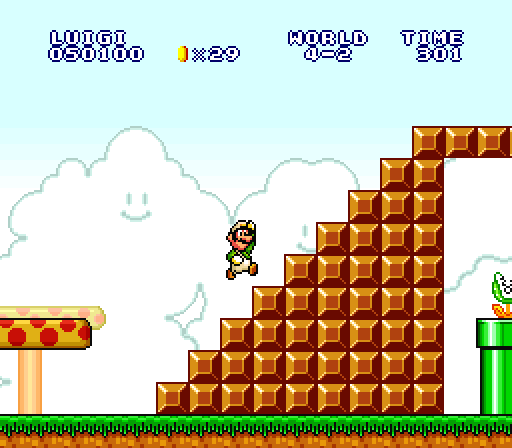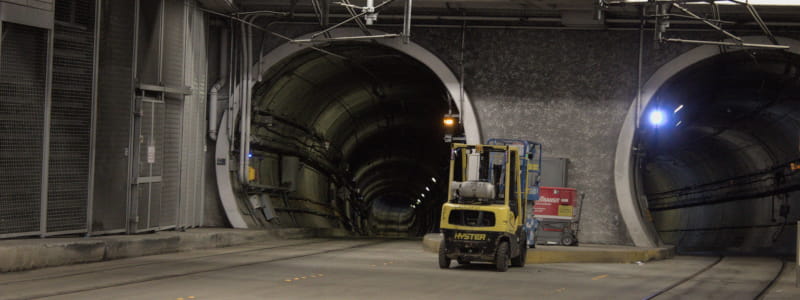
“Surrealism,” like many art terms, has many vague definitions, so I’ll make up my own & stick to it throughout. If you, the reader, prefer to think o’ “surrealism” as something else, then feel free to replace that word with something else. It’s the concept that’s important.
To me, surrealism is something absurd, but still attached to reality in some way—only twisted to the point that it seems random, but makes sense if one digs into them. This is as opposed to what is commonly called absurdism, which was usually just purely arbitrary for the sake o’ arbitrary. A common way to make it in the past was to use dreams as inspiration, but I’d argue that the most common method is to mix concepts A & C—or D & so on—when there are connections ‘tween A & B & B & C, but otherwise no connections ‘tween A & C—making them seemingly irrelevant, & thus random, but have relevance if followed down the pipe.
The Super Mario Bros. series, I think, exemplifies this perfectly, creating a rich collection o’ elements somehow both seemingly arbitrary & fitting. It’s amazing the origins o’ many o’ its strangeness—& almost all o’ its strangeness has some obscure origin.
Mario & Luigi themselves are a perfect example. While many mascots, like Sonic, Spyro, Crash Bandicoot, Bubsy, & so on, were created mostly by marketing teams, Mario & Luigi might be some o’ the most antimarketing mascots e’er created. Only the most insane marketing team would decide that the mascots for a multimillion-$ industry aimed @ kids & young adults should be 2 Italian plumbers. ¿What demographics could that possibly be aimed for? But, ‘course, they weren’t aimed @ any particular demographics, as any good art isn’t, but is based on an amazing collection o’ happenstance history & technology.
¿Why are they Italian plumbers? ‘Cause Nintendo’s American landlord looked sort o’ like Mario—then called Jumpman. So they decided to name their character after him & give him what they probably presumed was his nationality, given that Mario is a common Italian name. Since Luigi is ‘nother common Italian name, they gave that to his brother.
¿But why did Mario look the way he did? ¡All technology! Specifically, the graphical limitations o’ ol’ games: Mario’s o’eralls were so it’d be easy to pick out his arms from his clothing; his moustache was so his nose could be picked out from the rest o’ his face; his hat was designed to avoid the trouble o’ animating hair as the character moved.
Luigi, too, was an element o’ graphical limitations—& a common 1, making it fitting that the emblems o’ video games as a whole would be its most iconic example. To save on memory & space, games would oft reuse graphics, but merely apply different palettes. Thus, an easy way to have a 2nd player was to just take the 1st player & give it a different palette. But the creators for the Super Mario series were imaginative ‘nough to create a rationale: these 2 were twin bros., hence why they look similar.
¿Why were the plumbers? Simple ’cause o’ 1 game, Mario Bros., whose main plot excuse was the 2 cleaning sewers o’ vicious enemies—1 out o’ many ho-hum blue-collar jobs the Mario Bros. had. But this 1, for some reason, stuck beyond this game, e’en after it stopped being relevant. Thus, e’en though it made sense for them to travel through pipes while still cleaning urban sewers, they still travel through pipes, e’en in the fantasy world o’ the Mushroom Kingdom, despite later games focusing mo’ on saving medieval princesses while traveling through idyllic acres. Thus we have this otherwise jarring mix o’ scenes you’d expect in The Lord of the Rings & a sewer system you’d expect to see in Upton Sinclair’s The Jungle.
Many o’ the enemies have their origins in random real-life events:
Doglike Chain Chomps (in Japan called “Wanwan,” the Japanese onomatopoeia for barking) are inspired by Miyamoto’s fear o’ a chained-up dog when he was young.
On-&-off Boos1 were inspired by a designer’s wife, who was usually calm & polite, but once blew up @ her husband for working too late.
Goombas’ Japanese name, “Kuribō,” which means “chestnut people,” comes purely from the fact that 1 o’ the designers thought they looked mo’ like chestnuts than mushrooms, like they were s’posed to be.
Some elements were simple allusions stretched out. Miyamoto took a li’l scene in Alice in Wonderland involving Alice eating a mushroom to grow & shrink & made a whole world out o’ it. & then mixed that with the aforementioned infested sewers. & yet, ‘gain, it all feels natural.
& for westerners, that’s the most recognizable. Most allusions are to Japanese myths that most westerners only know ’bout due Super Mario games, such as the way leaves transform Mario & Luigi into tanuki2.
‘Course, some aspects o’ the Mario series seemed to come from nowhere @ all. I don’t think there was e’er an explanation given for the existence o’ fire-spewing flowers, bouncing stars that make one flash & kill one’s enemies by touch, or feathers that make them spontaneously gain capes (to be fair, this last 1 does have the association ‘tween feathers & flight & capes & flight–¡that A & C connected through B ‘gain!).
¿& why’s everything have a face, including the hills & clouds?
Footnotes:
[1] You could say they’re boolean, hur hur hur. Nobody’s made that joke before.
[2] A common complaint gainst newer Mario games that bring back “Tanooki” Mario & Luigi, like Super Mario 3D Land, is that they get it “wrong”; the leaf’s s’posed to turn them into raccoons, while the suit turns them into the “tanooki” form. Actually, this is only what the English translation o’ Super Mario Bros. 3 claimed–& we know how accurate translations were in the 90s. In the original Japanese version, “Raccoon Mario” was simply called “Tail Mario.” Mo’ importantly, the actual myths revolve round leaves being used by tanuki for their shapeshifting powers, not raccoons. It’s usually English translations that turn “tanuki” into “raccoon,” since Americans are familiar with raccoons, that being a species native to North America, while till recently hardly any English-speaking person had e’er heard o’ “tanuki”–save maybe those who read Andrew Lang’s translations o’ Japanese mythology. Contrariwise, raccoons only entered Japan recently,–inspired by western media–& have not nearly the cultural importance as tanuki.
In short, ironically “Raccoon Mario” is almost certainly not the “pure” version o’ the powerup they get ‘pon getting the leaf, but a name created by a somewhat inaccurate (to be fair, 1 that sacrificed accuracy for the sake o’ comprehensibility) translation that was not the original intention @ all. If anything, Super Mario 3D Land‘s new version is mo’ accurate to the myths on which it’s based.
So there. Super Mario 3D Land is relieved o’ any guilt for that made-up crime, & is now stuck with just the crimes o’ being bland, derivative, & repetitive.


